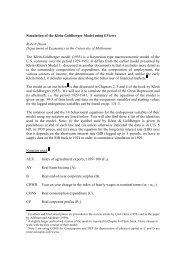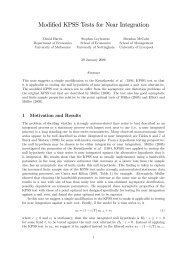Cobweb Theorems with production lags and price forecasting
Cobweb Theorems with production lags and price forecasting
Cobweb Theorems with production lags and price forecasting
Create successful ePaper yourself
Turn your PDF publications into a flip-book with our unique Google optimized e-Paper software.
Figure 2 shows the effect of the <strong>forecasting</strong> period m on the <strong>price</strong> behaviour, for c = 1.7<br />
<strong>and</strong> ℓ = 3. The first plot shows the logarithm of <strong>price</strong> πt for m = 1, α = (.7, .3) (the <strong>price</strong><br />
itself soon reaches values larger than 10 6 ). The next plot is the behaviour of πt when m = 5<br />
(α = (.2, .2, .2, .2, .1, .1)) <strong>and</strong> the last one when m = 7 (α = (.2, .1, .1, .1, .1, .1, .1, .1)). These<br />
plots hint at a stabilising effect of increasing m, <strong>and</strong> are consistent <strong>with</strong> other experiments we<br />
made.<br />
10 000<br />
5000<br />
�5000<br />
�10 000<br />
10 20 30 40 50 60 70<br />
(a) m = 1<br />
1.6<br />
1.4<br />
1.2<br />
1.0<br />
10 20 30 40 50 60 70<br />
(b) m = 5<br />
1.2<br />
1.1<br />
1.0<br />
10 20 30 40 50 60 70<br />
(c) m = 7<br />
FIGURE 2. As m increases, behaviour changes from unstable to stable.<br />
In Figure 3 the parameter c is varied, while ℓ = 3, m = 7 <strong>and</strong> α = (.2, .1, .1, .1, .1, .1, .1, .1).<br />
There is apparent stability, except that for the largest value of c there are oscillations of more or<br />
less constant amplitude. The last plot, where c = 3.8 shows nearly cyclical behaviour. Other<br />
experiments (not shown) <strong>with</strong> larger values of c caused the <strong>price</strong>s to diverge. Recall that in the<br />
classical cobweb stability occurs only if c < 1.<br />
1.2<br />
1.1<br />
1.0<br />
10 20 30 40 50 60 70<br />
(a) c = 1.7<br />
1.6<br />
1.4<br />
1.2<br />
1.0<br />
10 20 30 40 50 60 70<br />
(b) c = 3.0<br />
1.8<br />
1.6<br />
1.4<br />
1.2<br />
1.0<br />
0.8<br />
10 20 30 40 50 60 70<br />
(c) c = 3.8<br />
FIGURE 3. As c increases, behavior changes from stable to unstable.<br />
The rest of this section presents detailed discussions of particular cases, that sometimes show<br />
intriguing patterns which, to our knowledge, have not been noted in the context of economic<br />
cycles.<br />
2.1. The case m = 0. Suppose m = 0 <strong>and</strong> ℓ ∈ {1, 2, 3, . . . }. The <strong>price</strong> sequence satisfies<br />
πt+ℓ = −cπt.<br />
(Once again recall that the classical cobweb theorem has m = 0 <strong>and</strong> ℓ = 1.) The solution can<br />
be written as<br />
πkℓ−j = (−c) k π−j , k ∈ {1, 2, . . . }, j ∈ {0, . . . , ℓ − 1}.<br />
Here, there are ℓ <strong>price</strong> dynamics that work “in parallel”, i.e. they are not coupled. Each initial<br />
condition π−j determines πℓ−j, π2ℓ−j <strong>and</strong> so on. If 0 < c < 1 then there are damped oscillations<br />
that tend to zero as k → ∞. If c = 1 then oscillations of same amplitude <strong>and</strong> period 2ℓ persist<br />
endlessly, <strong>and</strong> if c > 1 then the log-<strong>price</strong>s alternate in sign but increase geometrically in size as<br />
time goes by. The role of the ratio of elasticities is clear in this case.<br />
6







